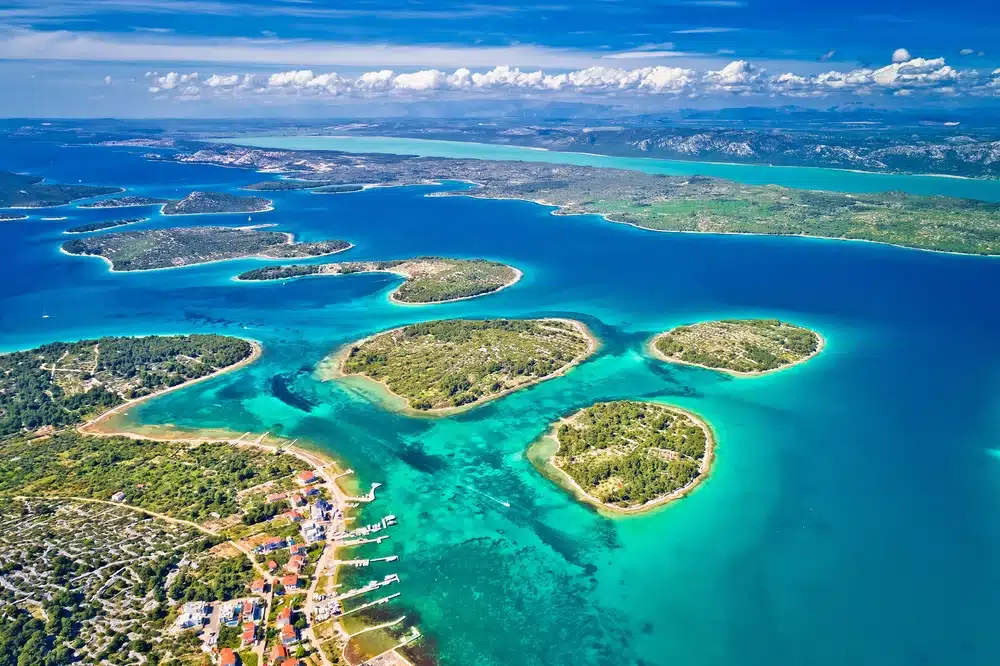History of Murter – From Ancient Times to the Present Day

Murter Island, located in the northwestern part of the Šibenik archipelago, is rich with a history stretching back millennia.
Its strategic position on the Adriatic, proximity to Kornati, and fertile soil made it attractive to numerous civilizations. Traces of life on the island date back to the Illyrian era, and throughout history, Murter has been an important trade, military, and cultural center.
Today, Murter is not only historically significant but also one of the most famous tourist destinations on the Adriatic.
Murter Through History – From Ancient Times to the Middle Ages
Ancient Period and Illyrian Settlements
The first known inhabitants of Murter were the Illyrians, specifically the Liburni tribe, who settled the island in prehistoric times. Hilltop settlements found on Gradina Hill testify to their presence. The Liburni were renowned as skilled sailors and traders, and their influence on the Adriatic remained strong until the arrival of the Romans.
With the arrival of the Romans, Murter became part of a broader network of Roman settlements. The most significant remnant from this period is the ancient city of Colentum, located on the southern side of the island. Colentum was an important port and settlement with developed infrastructure.
Excavations have revealed traces of Roman villas, streets paved with stone slabs, baths, and water cisterns. The city flourished during the reigns of Emperors Nero and Vespasian but was later destroyed—likely due to pirate raids or an earthquake.
Middle Ages – Murter’s Development Under Croatian Nobility
After the fall of the Roman Empire and the settlement of Croats in Dalmatia, Murter became part of the medieval Croatian Kingdom. The first written record of the island under its Croatian name, “Srimač”, dates to 1251, mentioned by Hungarian-Croatian King Bela IV.
During this period, there were two major settlements on the island: Veliko Selo (today’s Murter) and Jezera. Later, during Ottoman incursions inland, the population surged as refugees from the mainland settled on the island, founding the villages of Betina and Tisno.
Murter in the 16th and 17th Centuries – Resistance Against the Ottomans and Settlement Growth
In the 16th century, Murter came under the rule of the Venetian Republic, which provided defense against the Ottomans but imposed heavy taxes on the local population. During Ottoman attacks, the island became a refuge for people from the hinterland, particularly from Ravni Kotari.
Murter’s inhabitants during this period were primarily engaged in livestock farming, olive cultivation, and fishing—trades that remained vital in later centuries. During the Venetian-Ottoman wars, Murterans frequently participated in defensive battles and were known for their maritime expertise.
Raduč (Murter Island) – Strategic Role in Coastal Defense
One of the key defensive sites was Raduč Hill, with its highest peak at 125 meters above sea level. Due to its strategic position, military bunkers and underground tunnels were built here during World War II, serving as shelters. Today, these tunnels are an intriguing tourist attraction offering a unique glimpse into the island’s military past.
Murter from the 18th Century to Today – Modernization and Tourism
Austro-Hungarian Era and Infrastructure Development
Under Austro-Hungarian rule, Murter underwent modernization. In the 19th century, fishing, shipbuilding, and trade flourished, and in 1866, the first reading room was opened, reflecting the cultural advancement of the population.
20th Century – From World War II to a Tourist Destination
During World War II, Murter was a strategic point due to its proximity to Kornati and the ability to hide ships in its coves. After the war, the island became part of Yugoslavia, and tourism gradually began to grow.
In the latter half of the 20th century, tourism became the island’s primary economic sector. The first hotels, campsites, and apartments opened, and Murter was branded as a destination for nautical enthusiasts, divers, and cultural tourism lovers.
Murter Today – A Blend of Tradition and Modern Tourism
Today, Murter is one of the most visited tourist destinations in Dalmatia. The island successfully combines its rich history with modern tourist amenities. Notable events include the “Latinsko idro” regatta, which promotes traditional Murter gajeta boats and shipbuilding heritage.
Murter is also renowned for its cuisine, based on authentic recipes, fresh seafood, and premium olive oil.
Where to Stay on Murter?
If you plan to visit Murter and explore its rich history, it’s best to book accommodation in advance to ensure an ideal stay on the island.
Discover the offer of the best apartments on Murter and experience its authentic beauty!

Conclusion
The history of Murter is a fascinating tale of civilizations that shaped the island over millennia. From the Illyrians and Romans, through the Venetian Republic and Austro-Hungarian Empire, to modern tourism, Murter has always been a vital part of Adriatic history. Today, it is an attractive destination offering a blend of cultural heritage, natural beauty, and top-tier tourism.
If you wish to explore Murter’s history and enjoy its natural wonders, visit this unique island and experience it authentically!
Literature:
